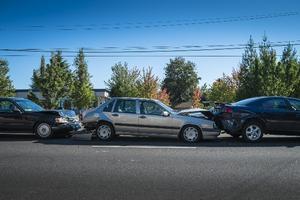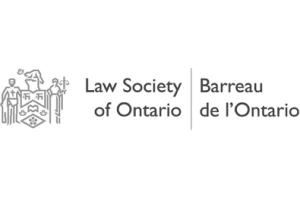Threshold
I Was Hurt in a Car Accident. What is the “Threshold” My Lawyer Keeps Talking About?
To commence a claim for injury sustained in any sort of situation you must be able to establish two major components. Damages and Liability. Let’s break that down into plain language.

Liability is the easier concept to grasp. Who caused the accident. Often there is more than one person responsible. For clarity we add an image example. If you were in the front car and were rear ended, it may not be the following driver entirely at fault as he/she was in turn rear ended starting the chain reaction. By following so closely that driver may not be completely off the hook but with only a few other vehicles involved it is relatively easy to sort out. If this was a large highway pileup, we would need to consult the Highway Traffic Act fault determination rules which you can review here. As lawyers rarely agree on anything, getting fault sorted out can be a challenge.
Damages is how we refer to your total losses. The injury you sustained that led to loss of health, loss of enjoyment of life and even loss of conjugal relations. No judge (or jury), should it get that far, can order any form of restitution but for a dollar amount so all of these items need to be quantified, documented and proven.
Special damages is the term for financial losses including out-of-pocket expenses, loss of income and loss of future income. These must be calculated and supported with credible documentation. A loss of earning report can cost thousands of dollars to obtain, so though needs to be given to the cost vs the potential recovery. If your situation is not complicated it may just require a simple calculation.
Additional to both of those issues, car accidents have the added requirement that personal injury claims must jump called “meeting the threshold”. If you do not meet it, regardless of liability and some damages, your claim will fail.
The threshold issue was first enacted in Ontario in 1990 in an attempt to reduce the number of motor vehicle accident claims which purportedly would keep auto insurance rates under control. The threshold works by imposing a standard of severity of injury that must be met for a plaintiff to be entitled to non-pecuniary (general) damages. It has been difficult, even for lawyers, to understand what will meet it and what will fail. An extract of the applicable section of the legislation follows:
Section 267.5 (5) of the Insurance Act, R.S.O. 1990 c. I.8.
Despite any other Act and subject to subsection (6), the owner of an automobile, the occupants of an automobile and any other person present at the incident are not liable in an action in Ontario for damages for non-pecuniary loss, including damages for non-pecuniary loss under clause 61(2)(e) of the Family Law Act, from bodily injury or death arising directly or indirectly from the use or operation of the automobile, unless as a result of the use or operation of the automobile the injured person has died or sustained,
(a) permanent serious disfigurement; or
(b) permanent serious impairment of an important physical, mental or psychological function.
The next problem faced by plaintiffs and their lawyers was the words “permanent”, “serious” and “important” which were not defined. A further amendment was added in 1993 to address concerns about clarity and to add a specific requirement to demonstrate that the threshold has been met.
The excerpt below is taken from the legislation so you can read it without wading through the more than 500 pages of the Insurance Act and Regulations:
4.1 For the purposes of section 267.5 of the Act, “permanent serious impairment of an important physical, mental or psychological function” means impairment of a person that meets the criteria set out in section 4.2. O. Reg. 381/03, s. 1.
4.2 (1) A person suffers from permanent serious impairment of an important physical, mental or psychological function if all of the following criteria are met:
1. The impairment must,
i. substantially interfere with the person’s ability to continue his or her regular or usual employment, despite reasonable efforts to accommodate the person’s impairment and the person’s reasonable efforts to use the accommodation to allow the person to continue employment,
ii. substantially interfere with the person’s ability to continue training for a career in a field in which the person was being trained before the incident, despite reasonable efforts to accommodate the person’s impairment and the person’s reasonable efforts to use the accommodation to allow the person to continue his or her career training, or
iii. substantially interfere with most of the usual activities of daily living, considering the person’s age.2. For the function that is impaired to be an important function of the impaired person, the function must,
i. be necessary to perform the activities that are essential tasks of the person’s regular or usual employment, taking into account reasonable efforts to accommodate the person’s impairment and the person’s reasonable efforts to use the accommodation to allow the person to continue employment,
ii. be necessary to perform the activities that are essential tasks of the person’s training for a career in a field in which the person was being trained before the incident, taking into account reasonable efforts to accommodate the person’s impairment and the person’s reasonable efforts to use the accommodation to allow the person to continue his or her career training,
iii. be necessary for the person to provide for his or her own care or well-being, or
iv. be important to the usual activities of daily living, considering the person’s age.3. For the impairment to be permanent, the impairment must,
i. have been continuous since the incident and must, based on medical evidence and subject to the person reasonably participating in the recommended treatment of the impairment, be expected not to substantially improve,
ii. continue to meet the criteria in paragraph 1, and
iii. be of a nature that is expected to continue without substantial improvement when sustained by persons in similar circumstances.O. Reg. 381/03, s. 1.
For interpretation of that wording we turn to judiciary decisions made. The first and most prominent is Meyer v. Bright as it has been referred to and applied to all subsequent threshold cases. Meyer v. Bright established the following 3-part test for threshold interpretation:
- Has the injured person sustained permanent impairment of a physical, mental, or psychological function?
- If yes, is the function which is permanently impaired an important one?
- If yes, is the impairment of the important function serious?
A plaintiff bears the onus of proving that his or her injuries fall within the threshold under this test.

One way to look at the “threshold test” is to consider the impact of a single reasonably straightforward injury. The loss of part of the ring finger on the non-dominant hand. How does this affect an individual. The same for a pianist vs a garbage collector? If the pianist was already retired from performing and now a piano teacher who could continue to earn the same income, would that impact your decision if you were on a jury?
Case law has endlessly attempted to interpret when the injury moves beyond tolerable to serious. Having threshold motions on an individual claim basis has not reduced the number of claims commenced but has significantly increased the complexity and the time required by our court system to adjudicate these cases.
When the Insurance Act is amended, the updates take effect on a specific date and impact the rules relating to car accidents that occur after that date while earlier collisions are guided by prior versions. The exact date of your accident determines what legislation is applicable and is the date from which the limitation starts to run. We will ask you for the date of the accident so that we know what system your claim involves.
After reading this, the next time a lawyer mentions “threshold issue” to you, we hope you have a better understanding of the issue and why there is no simple answer to the question of your claim meeting this burden.
If you have sustained a serious injury and require representation, please contact us. Hospital or home visits can be arranged if you are not able to travel to our office.








